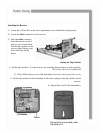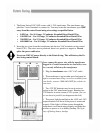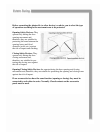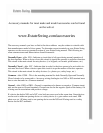
6.3
If fuse the F2 fuse blows or continues to blow.
Check all wiring to both the backup batteries and to all accessories run off of the 24+,- terminals
on terminal block CN1. Check for the following:
· The batteries are run in series not parallel. If they are run in parallel the batteries will be-
come overcharged and be destroyed, which will then create a short and continually blow
the F2 fuse.
· The accessories going into 24V+, - must have the correct polarity.
· The accessories going into 24V+, - cannot exceed a combined power draw of more than
500 mA.
Check the battery voltage, if the battery voltage is very low you may have dead cells in the bat-
tery causing an overdraw of current and blowing the fuse. Replace the batteries.
If the door reaches it’s closed position during the learning process but does not re-open.
Touch the reset pins (RST) to reset the system. Change the i parameter to 0. Restart the learning
process.
Contact Estate Swing for alternate power supply to correct a lack of correct voltage and/or amper-
age outputs under load.
The door does not reach the desired stop points.
If not using limit switches:
· Be sure the arm can go full expected range. Manually release the arms and move the doors
by hand to possible range. Do not let the arm reach its physical limitations before the
stops during normal operation.
· If arms can’t extend full expected range, check the setback. 6 ½ x 6-½ inch setback is the
correct setback for a 110-degree opening.
· If the opener arm has the physical possibility of opening yet still stops, increase the force
setting to the highest force. The force setting is the A parameter, move the A parameter to
4. If the door moves fully after doing so you may then work your way down force settings
to the lowest force setting that the door still moves correctly under. The ending positions
are where the most stress is put on the arm and the leverage is the lowest.
If using limit switches:
· Check limit switch placement and wiring. You can tell if a limit switch has been triggered
by watching to see if one of the lights above FCC1, FCA1, FCC2, FCA2 go unlit. Which-
ever limit light is unlit is engaged.
· If limit switches are to the furthest points possible on both the closed and open positions,
check the setback. 6 ½ x 6-½ inch setback is the correct setback for a 110-degree opening
· If the opener arm has the physical possibility of opening yet still stops, increase the force
setting to the highest force. The force setting is the A parameter, move the A parameter to
4. If the door moves fully after doing so you may then work your way down force settings
to the lowest force setting that the door still moves correctly under. The ending positions
are where the most stress is put on the arm and the leverage is the lowest.


















